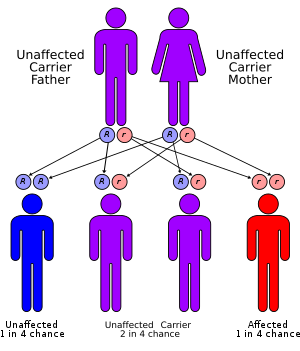Lucey–Driscoll syndrome
Lucey–Driscoll syndrome is an autosomal recessive metabolic disorder affecting enzymes involved in bilirubin metabolism.[1] It is one of several disorders classified as a transient familial neonatal unconjugated hyperbilirubinemia.
| Lucey–Driscoll syndrome | |
|---|---|
| Other names | Transient familial neonatal hyperbilirubinemia |
 | |
| Lucey–Driscoll syndrome has an autosomal recessive pattern of inheritance. | |
| Specialty | DiseasesDB = 32677 |
Cause
The common cause is congenital, but it can also be caused by maternal steroids passed on through breast milk to the newborn. It is different from breast feeding-associated jaundice (breast-fed infants have higher bilirubin levels than formula-fed ones).
Genetics
A defect in the UGT1A1-gene, also linked to Crigler–Najjar syndrome and Gilbert's syndrome, is responsible for the congenital form of Lucey–Driscoll syndrome.
Diagnosis
Treatment
gollark: Its computers are off and it may not have teleporters.
gollark: I don't actually know where it is or how it can be reached.
gollark: Probably.
gollark: No, GTech™ has Antimemetic Site-181 in the Nether.
gollark: From certain perspectives, you know, all is contained within the cuboctahedron.
References
- "Lucey-Driscoll syndrome | Genetic and Rare Diseases Information Center (GARD) – an NCATS Program". rarediseases.info.nih.gov. Retrieved 2017-08-27.
External links
| Classification | |
|---|---|
| External resources |
- Online Mendelian Inheritance in Man (OMIM): 237900 - transient familial neonatal hyperbilirubinemia, breast feeding jaundice included
This article is issued from Wikipedia. The text is licensed under Creative Commons - Attribution - Sharealike. Additional terms may apply for the media files.